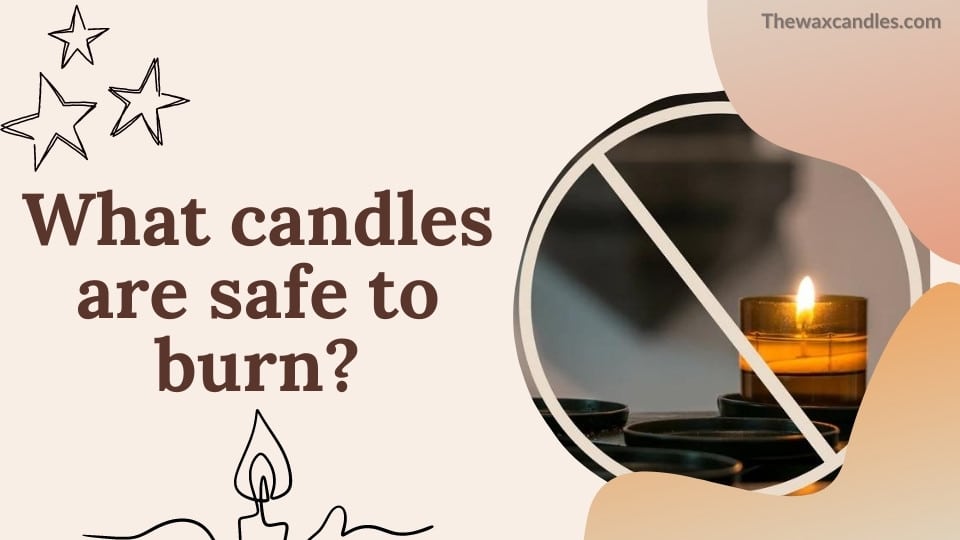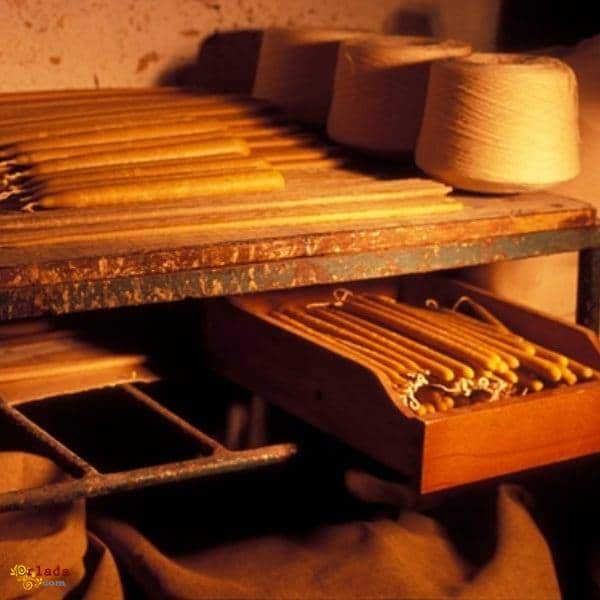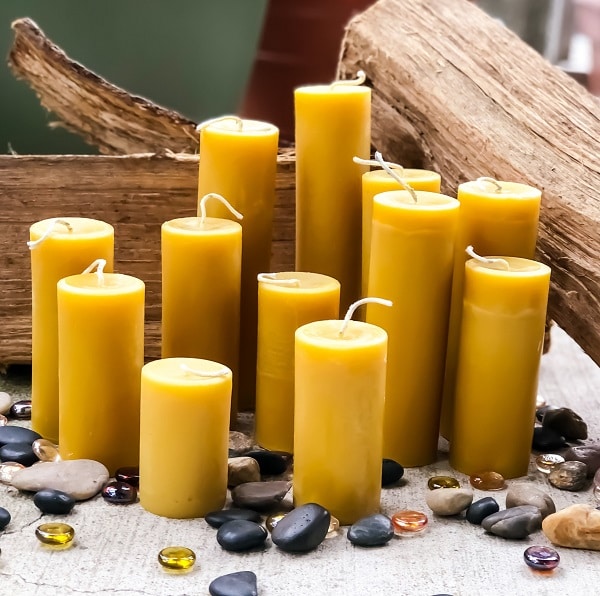
As the holiday season approaches, many of us will be looking for ways to add some warmth and light to our homes. Candles are one way to do this. But not all candles are created equal.
Some may contain lead or other harmful substances that can pose a health risk if they are burned nearby. So how can you tell which candles are safe? And what should you look for when you buy them? Read on to find out!
Which Candles are Safe for Your Health?
Soy, Paraffin, and Beeswax
Candles made with 100% GMO-free (genetically modified organisms), soy wax is the best. Soy wax is clean-burning and won’t leave your home or lungs clogged with dangerous pollutants, deadly smoke, or stains your walls or ceilings with black soot.
Burning paraffin wax can release a toxic mixture of chemicals into the atmosphere, including benzene (cancer-causing chemicals) and toluene.
Studies have shown that breathing in these harmful pollutants can lead to health problems such as cancer, common allergies, and even asthma.
Benefits of soy candles
Soy is a naturally occurring plant. Candles made from soy wax are made with oil from soybeans. Soy wax’s beauty is not limited to its clean burn. You can find out why your candles aren’t burning here.
- Paraffin wax candles can last up to half the time, while soy wax candles will burn twice as long. They will last longer than paraffin wax candles, even though they are more expensive.
- They also burn evenly, so there is no mushrooming effect like cheaper paraffin wax candles.
- Soy wax candles release their fragrances easier, which makes them more powerful.
- They require less heat to burn than paraffin, so they are safer.
Look for soy blend candles. These candles are likely to contain some soy and some paraffin. Instead, look for candles that are 100% soy. If in doubt, check the manufacturer’s website. If not, do not buy the brand.
A quick note about beeswax: Some soy candles contain beeswax, and beeswax, a natural substance, burns just as well as soy wax. If you are vegan and avoid all animal products, stick with 100% soy wax.
Soy candles are better for you, your family, and even your furry friends because they are less polluting and made from renewable, plant-based materials.
Fragrance/Scent
Avoiding scented candles is one of the best ways to test candles. Here are the reasons.
In most cases, each ingredient is listed on a product’s ingredient label. However, U.S. regulations classify complex mixtures of multiple natural and synthetic chemical components as “fragrance.”
The Fair Packaging and Labeling Act does not allow companies to force them to disclose “trade secrets.”
That’s okay, because complex mixtures can have thousands of components, including allergens and VOCs. These scented products can have adverse health effects on the general population.
Candles that contain only essential oils are recommended. These are oils extracted from whole plants and/or parts of plants. Transparent distributors and manufacturers will always be able to provide information about the oil extraction process (steam distillation, CO2 extraction, absolute, etc.). The country where the plant material was sourced to produce the oil.
Wicks
It is also necessary to decipher the wick labels before choosing a clean candle. These are some terms that people may be confused about.
- Terms such as “Lead-Free Wick.”
This means that the wick is not made of lead. However, it’s a bit of a greenwashing tactic since the Consumer Product Safety Commission banned the manufacture, import and sale of candles with lead wicks as of October 2003.
- Terms such as “Natural Cotton Wick.”
The term “Natural cotton Wick” refers to wicks made of cotton, but unless it does not say “unbleached,” the wick has been chemically bleached.
The No-Lead test
These steps will help you determine if a candle contains a lead-wick.
- When shopping for candles, look for “lead-free.”
- You can rub the wick off a candle that is still unburned. If the wick leaves a gray trace, similar to a pencil mark, it contains a lead core. Return the candle to the store if you have already bought it. Tell the manager why you want a refund.
- It would help if you threw out any metal cores from candles that have been burnt. Look at the tip to see if there is a metal core. If it isn’t apparent, you can always peel off some cotton.
Artificial Dyes and Fragrances
When a candle is scented or colored with artificial fragrances or dyes, it releases toxic chemicals.
Synthetic fragrances can cause hormone disruption, skin, eye and nose irritation, and damage to the liver and kidneys.
Consider candles that contain natural essential oils or fragrances (in safe concentrations). You can get the same aromatherapy benefits from organic oils as from scented candles, and even make your own scents.
Although essential oils are non-toxic, they can be very potent. You should research the best ways to use essential oils and the precautions you need to take. Pregnant women should not use essential oils. Consult a qualified aromatherapist first.
Candles that are safe to use
Instead of buying tons of candles with artificial scents and paraffin-based tealights, consider candles made from GMO-free soy, and you will be a blessing to your body and the planet.
Conclusion
Navigating the world of candles and their safety can seem complex, but armed with the right information, it’s entirely possible to enjoy the warm glow and comforting scents of candles responsibly.
Prioritizing candles made from natural waxes, like soy, beeswax, or coconut wax, and those with cotton or wooden wicks can greatly reduce potential risks. Remember, quality and reputation matter when choosing candles to ensure they’re free from harmful additives and dyes.
While there’s something inherently soothing about the flicker of a candle flame, it’s crucial to always practice good candle safety. Keep your candles away from flammable items, never leave them burning unattended, and maintain proper wick length to ensure a clean, even burn.
With these considerations in mind, you can create a cozy, inviting ambiance in your space, confident in the knowledge that you’re prioritizing the safety of your home and your health.
In the end, the safest candle is one used with care and consideration. So here’s to many relaxing, safe, and aromatic experiences with your favorite candles.
FAQ
Are all candles safe to burn?
While most commercially available candles are generally safe to burn, certain factors can affect their safety. This includes the type of wax, the presence of additives, the wick material, and how the candle is used.
Which types of candle wax are considered the safest?
Soy wax, beeswax, coconut wax, and other plant-based waxes are often considered the safest because they burn cleaner than paraffin wax, which is a petroleum byproduct and can release soot and potential toxins when burned.
Are scented candles safe?
Scented candles are generally safe for use. However, some people may have allergies or sensitivities to certain fragrances. It’s also important to ensure that the candles use high-quality, non-toxic fragrance oils.
What type of wick is safest for candles?
Wicks made from 100% natural fibers, such as cotton or wood, are considered the safest. Avoid wicks with a metal core, as they can sometimes contain lead.
Are colored candles safe to burn?
Colored candles are generally safe to burn, as long as the dyes used are non-toxic. However, excessive amounts of dye can cause a candle to burn improperly, so it’s always best to buy from reputable manufacturers.
What precautions should I take when burning candles to ensure safety?
Always burn candles on a heat-resistant surface away from flammable objects, and never leave them unattended. Trim the wick to about 1/4 inch before lighting, and extinguish the candle when 1/2 inch of wax remains to prevent overheating.
Are there any health risks associated with burning candles?
Some studies have linked prolonged exposure to soot particles from burning candles with potential health issues. However, the risk is generally low, especially when candles are used responsibly in a well-ventilated area.
Are there any environmentally friendly candles that are also safe to burn?
Candles made from plant-based waxes like soy, coconut, or sustainably sourced palm wax are not only environmentally friendly, but they are also generally safer to burn due to their lower soot production.
Sources:
https://www.wholesomehub.net.au/blog/which-candles-are-safe-for-your-health
https://www.takingcharge.csh.umn.edu/how-do-i-choose-and-use-essential-oils
https://www.candlescience.com/wax/soy-wax-trouble-shooting-guide
Carole Brooks has been making candles for many years. She loves to create candles of all different types and for all different purposes. Here she shares her experience and knowledge. Carole is a graduate of Texas A&M University.






